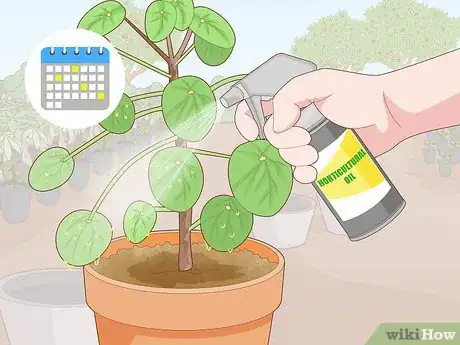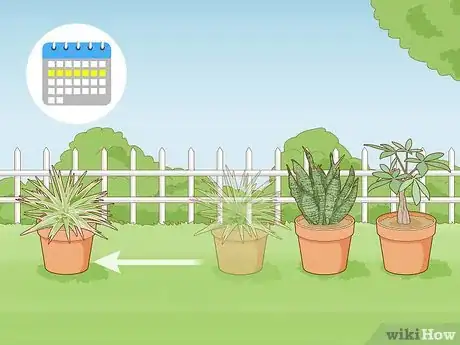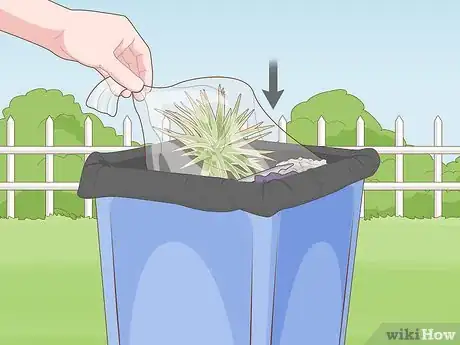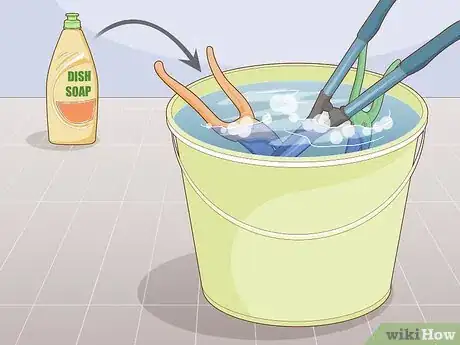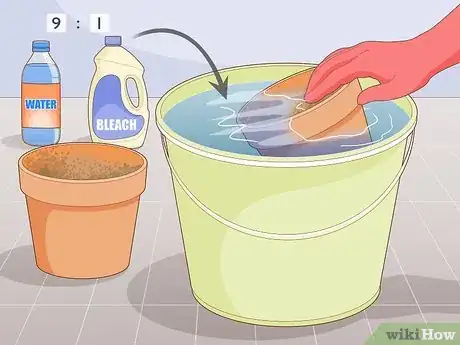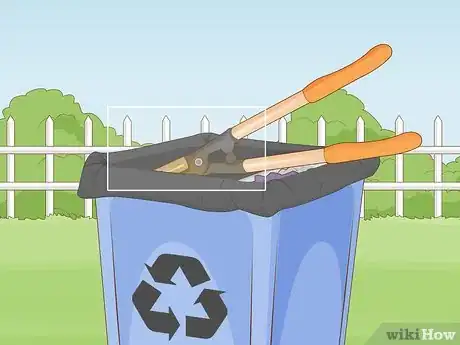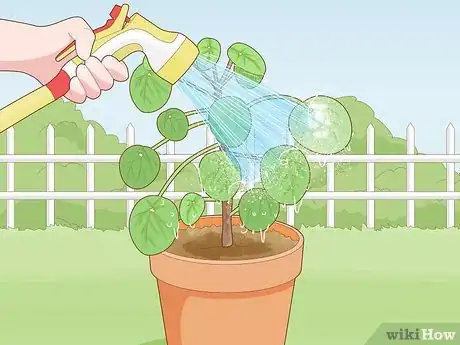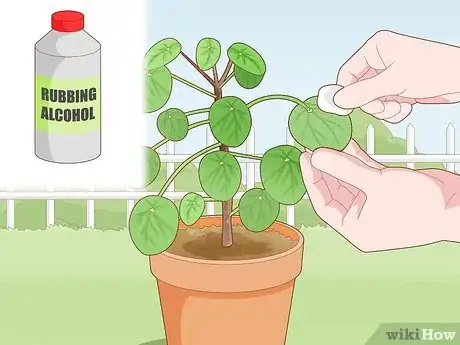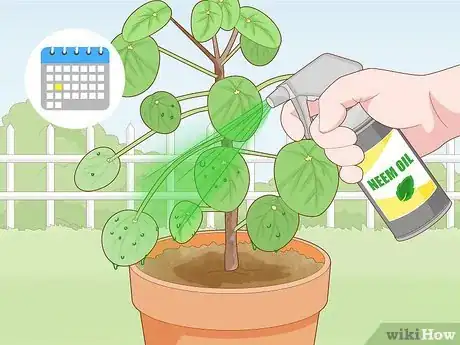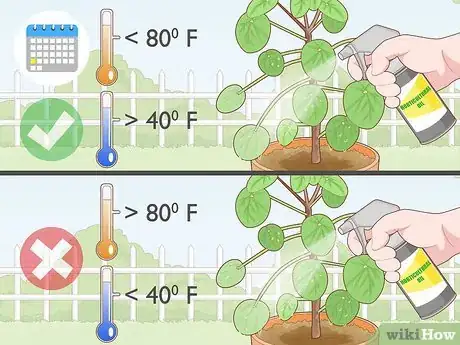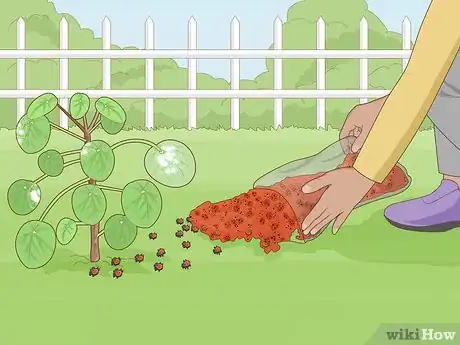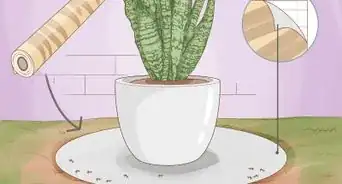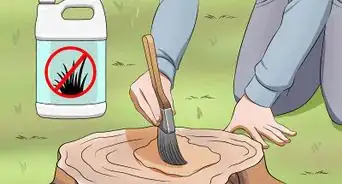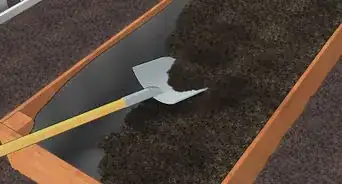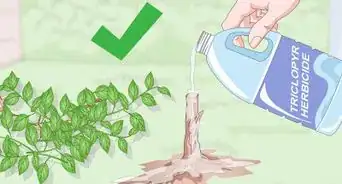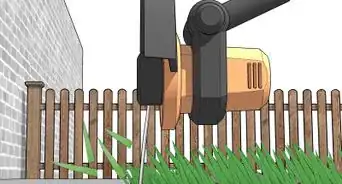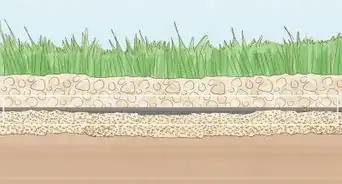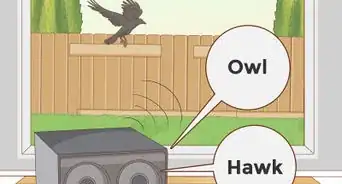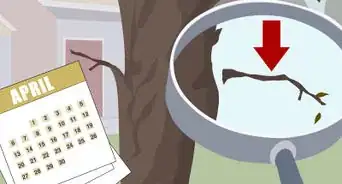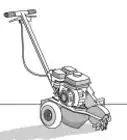This article was co-authored by Chris Parker and by wikiHow staff writer, Eric McClure. Chris Parker is the Founder of Parker Eco Pest Control, a sustainable pest control service in Seattle, Washington. With over seven years of experience, Chris specializes in Integrated Pest Management and doesn’t use any chemicals for pest removal. He offers removal services for ants, rodents, fleas, spiders, wasps, and more. Chris is a certified Commercial Pesticide Applicator in Washington State and received his bachelor’s from the University of Washington.
This article has been viewed 23,050 times.
Mealybugs are tiny garden pests that suck on the sap in plant stems. They’re a frustrating pest because they’re incredibly tiny, and they hide in crevices and gaps between branches which can make them hard to spot. In addition, 1 female can lay up to 600 eggs, which means infestations can grow rapidly and make the problem particularly hard to deal with.[1] Mealybugs prefer staying outdoors, so inspect plants carefully for signs of mealybugs before bringing them inside. Mealybugs are tiny white or pink critters that move slowly, so look carefully for these bugs on your plants. Other signs include holes near the base of leaves and white mold on the stem of your plant.
Steps
Quarantining New Plants
-
1Inspect plants carefully before bringing them into your home. Before you buy a plant from a nursery or gardening store, inspect the plant carefully for signs of mealybugs. Look for small, slow-moving insects that are white or light pink. They tend to feed on the tips of stems where the leaf grows, so look for bites or holes near the base of the leaves. Check the main stem and under the leaves for a cotton-like white mold. If a plant has any of these symptoms, mealybugs may be nesting in it and you should not take it home.[2]
- The white moldy material is excretion from the mealybugs. It’s a trademark sign of a particularly bad infestation.
Tip: You may not physically see any mealybugs. They burrow in the stems and branches of the plant and the male mealybugs are not visible to the naked eye. There may still be mealybugs on a plant, even if you don’t see them.
-
2Spray your plant with horticultural oil to kill mealybugs you can’t see. As a preventative measure, pick up some horticultural oil. Fill a sprayer or spray bottle with the oil and mist your plants in a thin layer of the solution. Mist the top of the plant, under the leaves, and around the base of the stem to ensure that you cover each section of the plant. This will remove any mealybugs on your plant that you can’t see.[3]
- Horticultural oil is an excellent natural pesticide. It will not harm your plants but it will suffocate any pests that are already on your plant.
- One application is typically enough to prevent non-visible infestations from growing. You can apply an additional layer after 7 days if you’d like, though.
Advertisement -
3Keep your plant in an isolated area for 1 week before planting or bringing it inside. Before you bring your new plant into your home or plant it in your garden, store it in an isolated part of your yard for a few days. Alternatively, you can keep it in a shed or garage next to a window. Inspect your plant daily for signs of mealybugs to ensure that the plant is safe to keep.[4]
- Mealybug eggs can take months to hatch. It’s not realistic to quarantine your plant for that long, and 1 week is typically long enough for you to recognize signs of adult mealybugs.
-
4Discard your plant or try to recover it as you spot mealybugs. At the first sign of mealybugs, assess whether the plant can recover. If the plant is absolutely covered in white mold and all of the leaves look eaten through, you’re better off simply discarding it. If the problem doesn’t look too bad, you can begin addressing the bugs and treating your plant.
- If you find the mealybugs on an outdoor plant already in your garden, quarantine it. Then, treat the plants that were surrounding the infected plant, even if you don’t see any signs of mealybugs.
- If mealybugs are infesting a large number of plants in your garden, it’s not worth digging them out and quarantining them. Simply deal with the problem where your plants happen to be.
Sanitizing Your Planting Equipment
-
1Sanitize your planting and gardening equipment to avoid infestations. Before planting or working on your plants, clean and disinfect your gardening tools. Wash each tool under warm water and use dish soap to remove dirt and debris. Then, use a household disinfect or bleach to sanitize your tools. This will ensure that your plants stay healthy as you work on them and keep mealybugs and eggs off of any tools that came in contact with them without your knowledge.[5]
- Use pine oil instead of bleach or disinfectants if you want a less abrasive option.
- Do this every time that you use your tools to prune, plant, or dig.
-
2Wash used pots out before reusing them for new plants. If you’re planting a plant in an old pot, clean it thoroughly before reusing it. Rinse the pot under a steady stream of water to remove the old soil. Then, put on some rubber gloves and use a solution of 9-parts water and 1-part bleach to soak your pot for 3-4 hours. This will kill any diseases and pests that are sticking around on your pot. Let the pot air dry indoors before reusing it with a new plant.[6]
Tip: You can simply rinse plastic pots. You don’t need to disinfect them since pests and diseases can’t dig hide inside the plastic.
-
3Throw away any equipment that you use to deal with heavily infested plants. If you’ve just finished dealing with a mealybug infestation, throw out any tools and pots that came in contact with the mealybugs. While you may be able to wash and disinfect them, it’s not worth risking a major infestation by spreading mealybug eggs to other parts of your garden.[7]
Dealing with Mealybugs
-
1Spray infested plants with a firm stream of water. Mealybugs are not particularly strong and you can knock off a large number of adult bugs simply by spraying the affected plant with a firm stream of water. Aim your hose at an angle where the bugs will fly off away from your home or garden and spray every portion of the plant with water. Mealybugs aren’t particularly resilient, and any bugs you knock off will simply wander off to look for a new plant.[8]
- Do not make the water pressure on the nozzle so high that you destroy the plant. Use a nozzle setting that is firm enough to put some pressure on the plant, but not so hard that it rips leaves or flower buds off.
-
2Use rubbing alcohol to physically wipe affected areas and kill bugs. Grab a cotton swab and dip it in rubbing alcohol. Then, use the tip of your cotton swab to physically rub off the white mold left behind by mealybugs. To kill the bugs on your plant, dip a soft paper towel or cloth into rubbing alcohol. Gently brush the portions of your plant that are affected by the mealybugs with your paper towel.[9]
- Alternatively, you can fill a spray bottle with 10-25% isopropyl alcohol and mist the affected plants. Do this once a week until the mealybugs are gone.
-
3Coat your plants in neem oil to keep mealybugs from eating your plant. Neem oil is a natural protective coating that will coat your plants in a nutrient-rich oil and make it harder for bugs to feed. Purchase some neem oil from a gardening store. Wait for the sun to go down and liberally spray your plants’ stems, leaves, and roots with the neem oil. Reapply your neem oil every 15-30 to continue starving the mealybugs.[10]
- Neem oil will also suffocate some pests that are already firmly established in your garden. Unfortunately, it may also kill ladybugs and other insects that are good for your garden.
- Neem oil is completely natural and it is extracted from neem trees. It won’t damage your plants on its own, but some plants may not thrive when covered in too much oil. If any of your plants struggle to flourish after you apply the neem oil, stop using it.
-
4Kill the mealybugs with horticultural oil. Horticultural oil is a petroleum- or vegetable-based insecticide that suffocates bugs and protects your plants. It is the best treatment option for getting rid of mealybugs without harming your plants. Get some horticultural oil and pour it into a handheld sprayer or spray bottle. Mist your plants liberally and spray under the leaves of the infested plants. Reapply the oil every 2-3 weeks for the next month to kill any mealybug eggs that hatch.
- Never apply horticultural oil if it’s hotter than 80 °F (27 °C) or colder than 40 °F (4 °C).
Variation: You can use insecticidal soap instead of horticultural oil if you prefer, but insecticidal soap may damage some plants if you apply too much of it.
-
5Buy mealybug ladybirds to naturally control outdoor infestations. Mealybug ladybirds, also known as cryptolaemus montrouzieri, are a species of beetle that absolutely decimates mealybug populations. Purchase 200-1,000 mealybug ladybirds online or from a pest prevention company and release them in your garden near the affected plants. Wait 1-2 weeks for the mealybug ladybirds to eat all of the mealybugs on your plant or in your garden.
- This is not a particularly good preventative measure, since the mealybug ladybirds will simply leave your garden if there isn’t any food there for them.
- While they have the word “mealybug” in their name, mealybug ladybirds are not actually a species of mealybug. They won’t harm or eat your plants.
Expert Q&A
-
QuestionHow can you deal with an infestation of mealybugs inside the home?
 Chris ParkerChris Parker is the Founder of Parker Eco Pest Control, a sustainable pest control service in Seattle, Washington. With over seven years of experience, Chris specializes in Integrated Pest Management and doesn’t use any chemicals for pest removal. He offers removal services for ants, rodents, fleas, spiders, wasps, and more. Chris is a certified Commercial Pesticide Applicator in Washington State and received his bachelor’s from the University of Washington.
Chris ParkerChris Parker is the Founder of Parker Eco Pest Control, a sustainable pest control service in Seattle, Washington. With over seven years of experience, Chris specializes in Integrated Pest Management and doesn’t use any chemicals for pest removal. He offers removal services for ants, rodents, fleas, spiders, wasps, and more. Chris is a certified Commercial Pesticide Applicator in Washington State and received his bachelor’s from the University of Washington.
Pest Control Specialist We typically see them in damp, dark areas, such as basements and under foundations. If the basement isn't sealed off properly, for example, the downstairs door has a gap underneath it, then you will get more mealybugs. A door sweep with some proper weather stripping could prevent an infestation. You could also use dehumidifiers.
We typically see them in damp, dark areas, such as basements and under foundations. If the basement isn't sealed off properly, for example, the downstairs door has a gap underneath it, then you will get more mealybugs. A door sweep with some proper weather stripping could prevent an infestation. You could also use dehumidifiers.
Things You’ll Need
Sanitizing Your Planting Equipment
- Water
- Dish soap
- Bleach
- Rubber gloves
Dealing with Mealybugs
- Neem oil
- Water
- Mealybug ladybirds
- Horticultural oil
References
- ↑ https://www.canr.msu.edu/news/mealybugs_a_common_pest_of_indoor_plants
- ↑ https://www.canr.msu.edu/news/mealybugs_a_common_pest_of_indoor_plants
- ↑ https://extension.tennessee.edu/mtnpi/Documents/handouts/Insect%20and%20Disease%20Control/Horticultural_Oil_Handout.pdf
- ↑ https://www.canr.msu.edu/news/mealybugs_a_common_pest_of_indoor_plants
- ↑ https://gardeningsolutions.ifas.ufl.edu/care/tools-and-equipment/disinfecting-tools.html
- ↑ https://aces.nmsu.edu/ces/yard/2007/092207.html
- ↑ http://ipm.ucanr.edu/PMG/PESTNOTES/pn74174.html
- ↑ http://ipm.ucanr.edu/PMG/PESTNOTES/pn74174.html
- ↑ http://ipm.ucanr.edu/PMG/PESTNOTES/pn74174.html
- ↑ http://ipm.ucanr.edu/PMG/PESTNOTES/pn74174.html
- ↑ http://ipm.ucanr.edu/PMG/PESTNOTES/pn74174.html
- ↑ https://www.canr.msu.edu/news/mealybugs_a_common_pest_of_indoor_plants
- ↑ http://ipm.ucanr.edu/PMG/PESTNOTES/pn74174.html
- ↑ http://blogs.ifas.ufl.edu/marionco/2018/02/12/overwintering-pests-lady-bugs-stink-bugs/

